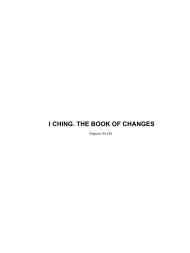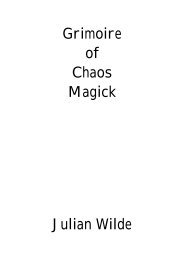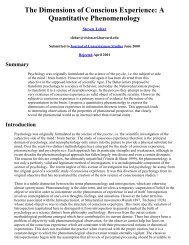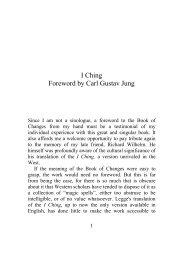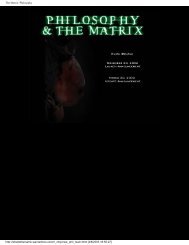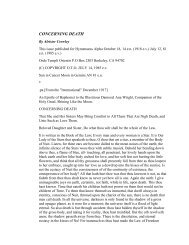Pernety - A Treatise On The Great Art.pdf - cyjack.com
Pernety - A Treatise On The Great Art.pdf - cyjack.com
Pernety - A Treatise On The Great Art.pdf - cyjack.com
You also want an ePaper? Increase the reach of your titles
YUMPU automatically turns print PDFs into web optimized ePapers that Google loves.
<strong>The</strong> <strong>Great</strong> <strong>Art</strong> page 46<strong>com</strong>posed of an oily viscous Earth and a limpid Water; Sulphur of very dry, very subtle Earth, mixedwith the moisture of the Air; Salt of a thick, ponderous Earth and a crude Air which finds itselfentangled with it. (See the Physique Souterraine, by Beccher).Democritus 37 has said that all the Mixts were <strong>com</strong>posed of atoms; this belief seems not to be farfrom the truth, when we notice what reason dictates and experience demonstrates to us. Thisphilosopher, as the others, has verified, under this obscure manner of explaining himself, the truemixture of the Elements, which in order to be conformable to the operations of Nature, must be madeintimately, or, as we say, per minima et actu indivisibilia corpuscula. Without this the parts wouldnot make a continuous whole. <strong>The</strong> Mixts are resolved into a very subtle vapour by artificialdistillation; and is not Nature a more skilful workman than the most experienced man? This is all thatDemocritus has wished to say.Of the General Aspects of the MixtsWe notice three manners of being, (Cosmop. Nov. lum. Chem. Tr. 7), which constitute three genera,or three classes, called Kingdoms, the Animal, the Vegetable and the Mineral. Minerals are producedin the earth alone; vegetables have their roots in the earth, and rise in the water and the air; animalsare born in the air, the water and the earth; and air is a life-principle of all.Whatsoever different the Mixts appear to be as to their exterior form, they do not differ in principle,(Cosmop. Tract. 2); the Earth and Water serve as a basis for all, and the Air enters into their<strong>com</strong>position only as an instrument, as does Fire. <strong>The</strong> Light acts upon the Air, the Air on the Water,the Water on the Earth. Water often be<strong>com</strong>es the instrument of mixture in works of <strong>Art</strong>, but thismixture is only superficial; we see it in bread, bricks, etc. <strong>The</strong>re is another intimate mixtion whichBeccher calls Central, (Phys. sub. sect. I., ch. 4). It is that one by which the Water is so mixed withthe Earth that they can not be separated without destroying the form of the Mixt. We will not enterinto the detail of the different degrees of this cohesion, as we wish to be brief. All this can be seen inthe work just quoted.Of the Differences between the Three Kingdoms<strong>The</strong> MineralWe say ordinary of minerals that they exist, and not that they live, as we say of animals andvegetables; nevertheless we may say that the metals derive life in some manner from the minerals,either because in their generation there is, so to speak, a union of male and female under the name ofSulphur and Mercury, which by fermentation, circulation and continuous concoction, are purified bythe aid of the Salt in Nature, and finally are formed into a mass which we call metals; or because theperfect metals contain the principle of life, or innate Fire, which be<strong>com</strong>e weak and without movementunder the hard exterior which encloses it; a principle which is concealed there as a treasure, untilbeing freed by a philosophical solution of this exterior, it is developed and exalted by a vegetativemovement, to the highest degree of perfection which <strong>Art</strong> can give it.<strong>The</strong> Vegetable37 Greek Mystagogue and Alchemist, born in Thrace 460 B. C., founder of the atomic system.



